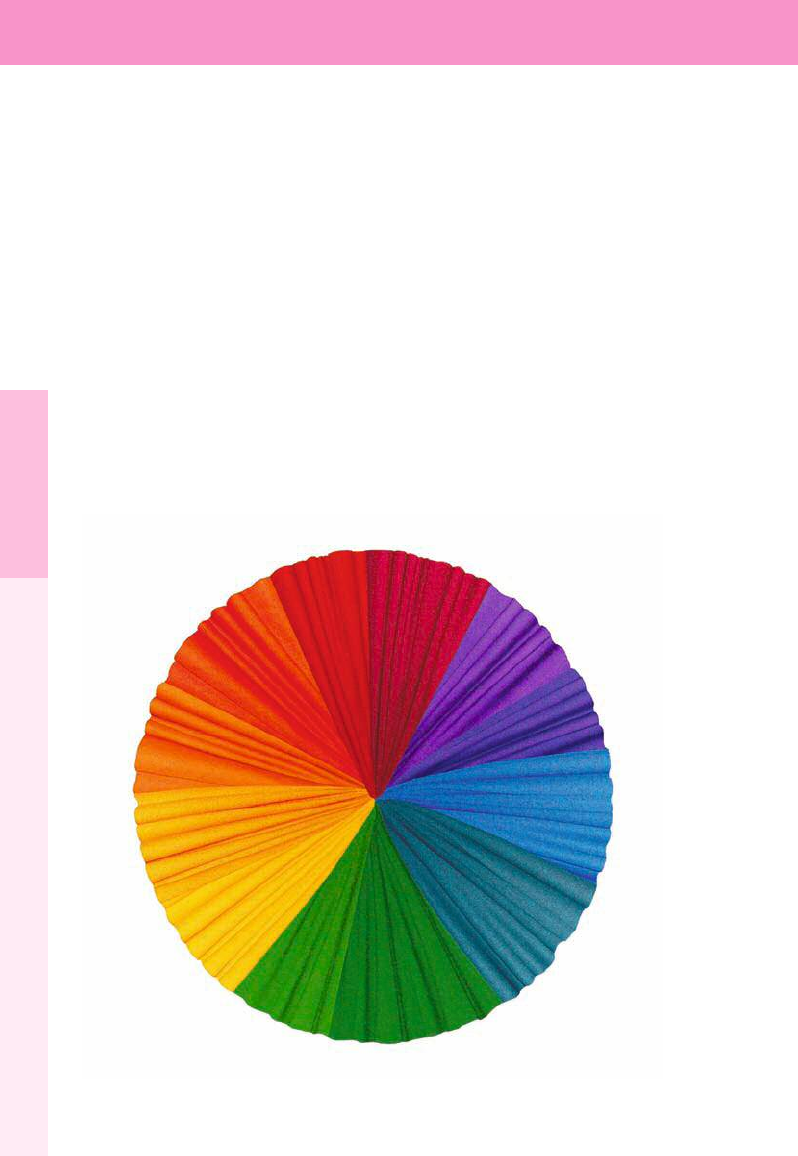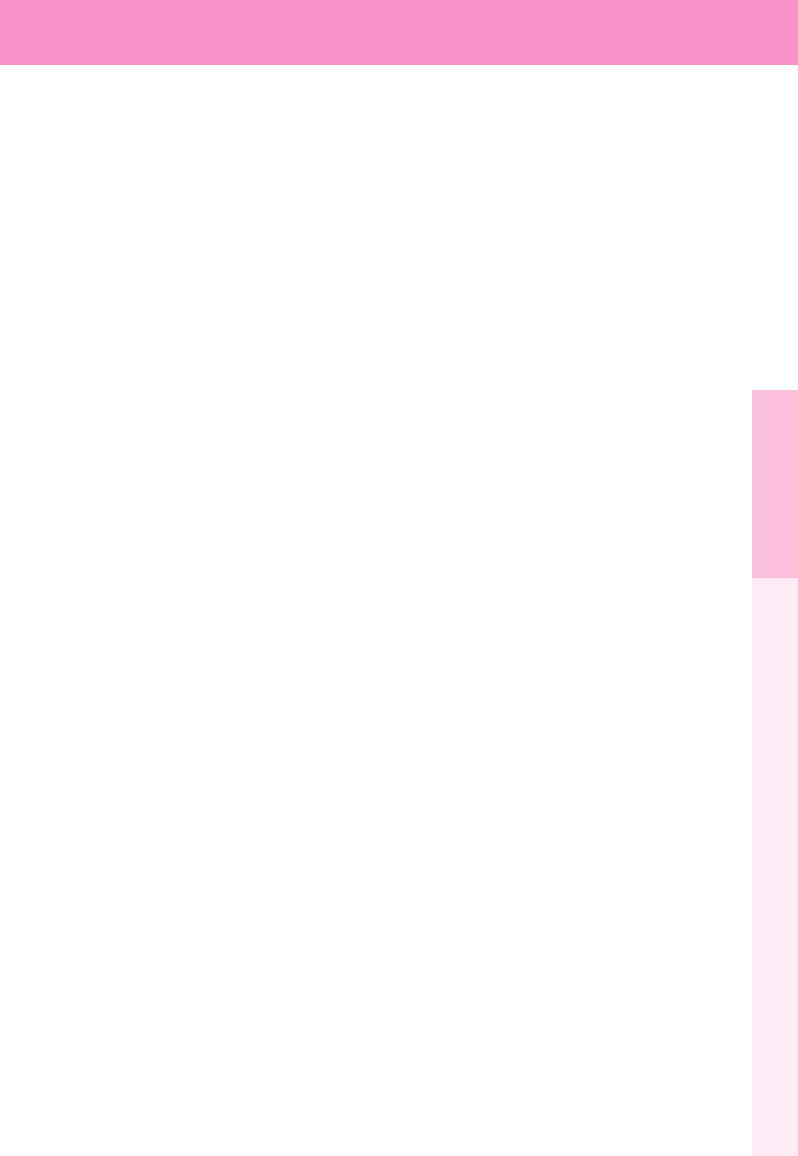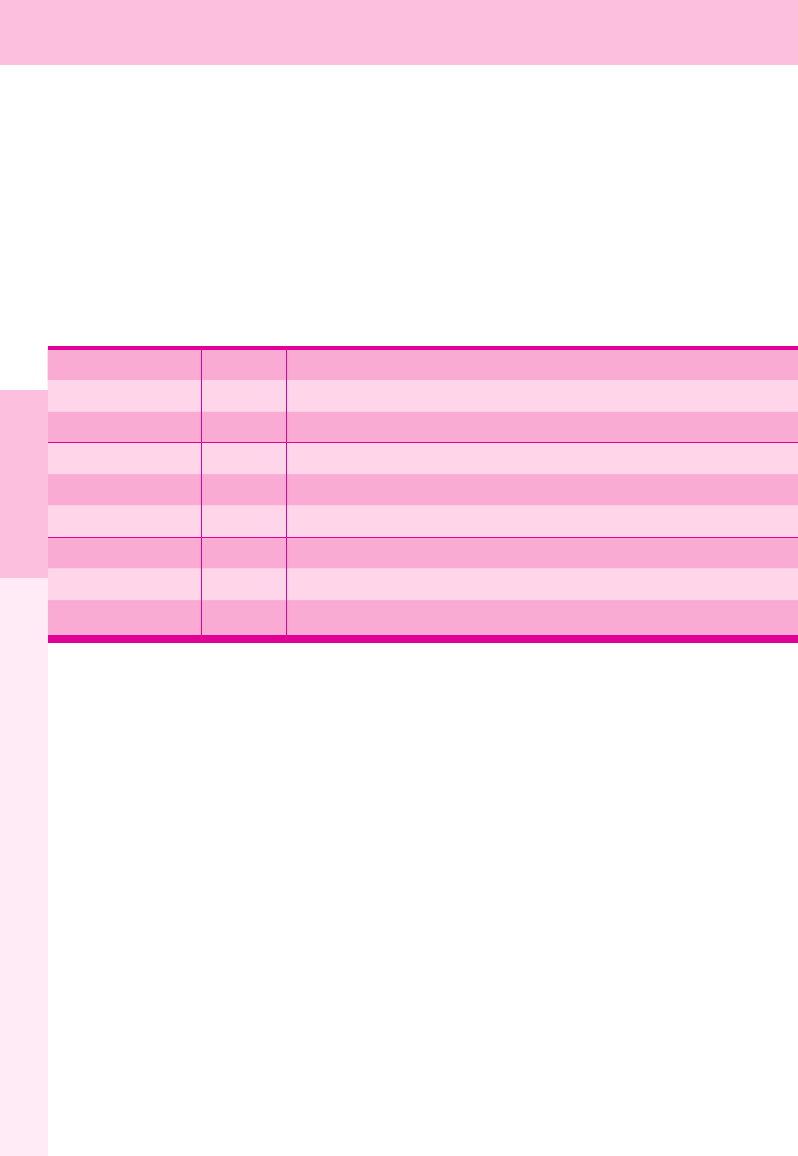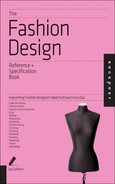
Job:02-30034 Title:RP-Fashion Design Ref and Spec Book
#175 Dtp:225 Page:110
108-115_30034.indd 110 2/27/13 4:28 PM
110 THE FASHION DESIGN REFERENCE + SPECIFICATION BOOK
(Text)
Chapter 10: Color
In fashion, color is the domain of chemists who develop pigments and art-
ists who manipulate the full chromatic spectrum. The rst are concerned with
practical matters affecting the use of color in manufacturing. Is a dye color-
fast? How does it respond to heat and moisture? Is it toxic? Does it stain? The
latter address the environments in which color will be encountered, taking into
account the season, time of day, location, and activity for which a garment is
designed.
Once the tangible properties of color have been established, the designer’s job
is to analyze how it will affect a design when integrated into the mix of silhou-
ette, pattern, texture, and detail. The impact on consumers and their response
is the least predictable factor in the equation, due to the complex dynamics of
culture, psychology, physiology, and even language.
U
C
C
a
fa
th
th
by
d
p
in
P
T
so
go
d
st
b
ri
A
a
c
o
in
a
S
w
B
b
P
B
h
h
i
n
co
p
W
w
10
Job:02-30034 Title:RP-Fashion Design Ref and Spec Book
#175 Dtp:225 Page:110
108-115_30034.indd 110 2/27/13 4:28 PM

Job:02-30034 Title:RP-Fashion Design Ref and Spec Book
#175 Dtp:225 Page:111
Book
e:110
108-115_30034.indd 111 2/27/13 4:28 PM
111
(Text)
UNDERSTANDING COLOR
Culture
Cultural stereotypes in f ashion can be explored through deeply ingrained preconceptions
about color. Say the w ord “red,” or display a sw atch of the vibrant color, and in relation to
f ashion it could bring to mind a provocative red dress. One might then associate the image of
the dress w ith a Latin aesthetic, re ecting the passion and sensuality of ten associated w ith
this culture. Yet in Asian societies an intense vermillion symbolizes prosperity and is also w orn
by brides. Understanding the connotations that a color carries f rom culture to culture and f or
dif f erent social groups can clarif y and enhance the designer’s thinking. In f act, a personal
pref erence f or or an aversion to particular colors is the of ten rst cultural stimulus introduced
into the design process.
Psychology
The psychology of color can be tricky because of the unpredictability of any individual’s as-
sociations w ith a hue. These bonds may have been f orged by numerous personal experiences,
good or bad. If people believe that they can’t w ear a particular color, only the most sensitive
designer can help them see the role that it might play w ithin their w ardrobe palette. Harder
still to dispel is the notion that one shouldn’t w ear a color— perhaps because of hair color,
body type, or age. Here the designer has an opportunity to in uence how color might be expe-
rienced in a new w ay.
A good example of how perceptions change is the color pink. Present it as a color option f or
a man today and he might shy aw ay, because modern-day men have been trained to link the
color w ith all things f eminine. Less than a century ago, how ever, many little boys w ere dressed
in pink, w hile girls w ore blue: Pink w as held to be a stronger color (akin to red) and blue sof ter
and more delicate. What altered so deeply the gendered af nity or aversion to pink? Did Elsa
Schiaparelli’s signature shocking pink contribute to the shif t in the 1930s and 1940s? What
w as the impact of the Nazi’s association of pink w ith homosexuality? Did the introduction of
Barbie in 1959 tip the scales f arther still? Little girls playing w ith dolls branded in pink could
be a pow erf ul image to contend w ith, even subconsciously.
Physiology
Beyond how people f eel about color is how their bodies might respond to it. Many colors
have been attributed w ith the pow er to induce a physical reaction. Correlations exist betw een
how the human body reacts to colors in nature and how it responds w hen similar colors are
introduced in arti cial contexts. A blue the color of a clear sky creates a soothing ef f ect; by
contrast, red, the color of blood or re, is know n to stimulate. Designers should keep the
physiology of color in mind as they imagine their customer and their customer’s audience.
When a w oman chooses betw een a pale blue dress and a similar scarlet one, she is aw are of
w hat response she might evoke in those w ho see her w ear it.
10
Job:02-30034 Title:RP-Fashion Design Ref and Spec Book
#175 Dtp:225 Page:111
Book
e:110
108-115_30034.indd 111 2/27/13 4:28 PM

Job:02-30034 Title:RP-Fashion Design Ref and Spec Book
#175 Dtp:225 Page:112
108-115_30034.indd 112 2/27/13 4:28 PM
112 THE FASHION DESIGN REFERENCE + SPECIFICATION BOOK
(Text)
Nomenclature
The semantics of style are now here more important than in a discussion of color. A red by
any other name . . . makes all the dif f erence in any dialogue a designer initiates. Unique and
descriptive names f or color help to paint a picture that more clearly re ects how designers
envision the setting f or their w ork. Designers can experiment w ith the associations suggested
by the colors of f oods, ora, and f auna. Gemstones are a great source of inspiration f or color
inf used w ith light. Technology, tools, and transportation may serve as a conduit to a w orld of
terminology attributed to the color of man-made objects.
COLOR NAMES
Primary Red
Bordeaux, Rose, Crimson, Pomegranate, Fire Engine, Scarlet
Yellow
Goldenrod, Buttercup, Lemon, Banana, Amber, Mustard, Canary
Blue
Royal, Navy, Cobalt, Sapphire, Azure, Indigo, Aquamarine, Turquoise
Secondary Orange
Rust, Pumpkin, Coral, Carrot, Salmon, Tangerine, Sienna, Tomato
Green
Grass, Avocado, Forest, Mint, Emerald, Kiwi, Chartreuse, Moss, Olive
Purple
Violet, Grape, Amethyst, Plum, Eggplant, Lilac, Lavender, Magenta
Neutrals Black
Noir, Jet, Coal, Ebony, Sable, Raven, Caviar, Onyx, Ink, Licorice
Grey
Charcoal, Slate, Silver, Steel, Stone, Ash, Smoke, Shark, Cement
White
Old Lace, Magnolia, Seashell, Ivory, Milk, Dove, Pearl, Frost, Cotton
The Senses
In the world of f ashion, color is more than just a visual experience. Beyond the observation
of color, there is participation. Color is tactile— something that is touched when woven into
cloth. Although a f abric might be craf ted of the same bers, color transf orms its perception,
eliciting dif f erent responses. Color also moves. The swing and ow of chif f on versus shantung
inf uses color with dif f erent levels of energy. Color may even have a sound, as when it de nes
the rustle of crisp papery silk. Designers must consider how the brain processes multisensory
inf ormation and then attributes many intangible, but of ten interesting properties to color.
COLOR STORIES
Color is such a subjective consideration, especially as it pertains to f ashion, that ideas on
color combining are f ound in many ways: dedicated scholarly research, casual perusal of art
books and f ashion magazines, or random ashes of inspiration while going about a normal
day. The elements of the mix boil down to pure color, shades, and tints. Each term is a way to
describe the volume at which a color story is being told and the style or tone in which it is be-
ing delivered. Dark color stories might speak with a sense mystery, while pastel stories might
s
I
n
st
M
M
dy
M
cr
s
lig
co
M
M
a
in
p
of
th
10
Job:02-30034 Title:RP-Fashion Design Ref and Spec Book
#175 Dtp:225 Page:112
108-115_30034.indd 112 2/27/13 4:28 PM

Job:02-30034 Title:RP-Fashion Design Ref and Spec Book
#175 Dtp:225 Page:113
Book
e:112
108-115_30034.indd 113 2/27/13 4:28 PM
Color 113
(Text)
d
g
y
o
speak with a sweet innocent voice. Pure colors are bright, powerful, and sometimes playful.
In creating a collection of garments, designers must carefully work the actual colors to under-
stand how they gure in their speci c tale.
Monochromatic
Monochromatic color stories for garments can be interpreted in many ways. Fabrics can be
dyed with the purest form of a color or with colors that represent different levels of saturation.
Multiple levels of the same hue are combined to create a tonal palette. Since fabric can be
created with any number of textures, the opacity of a color also comes into play: A sheer fabric
such as chiffon can be layered to create the illusion of multiple color tones. Surfaces re ect
light in different ways, so a faux fur, a patent leather, and an organza all dyed with the same
color will have distinct readings.
Saturation Opacity
Muted
Muted color stories are developed in two distinct ways. Adding black to a color will result in
a shade of that color. Shades such as these suggest a darker color story and are often used
in fall/winter collections. Adding white will tone down a color to create a tint. The effect is a
pastel story, which is usually applied to spring/summer collections. There are no fixed rules,
of course, so designers can employ any combination of shades and tints in ways that speak to
their vision.
Shades Tints
10
Job:02-30034 Title:RP-Fashion Design Ref and Spec Book
#175 Dtp:225 Page:113
Book
e:112
108-115_30034.indd 113 2/27/13 4:28 PM

Job:02-30034 Title:RP-Fashion Design Ref and Spec Book
#175 Dtp:225 Page:114
108-115_30034.indd 114 2/27/13 4:28 PM
114 THE FASHION DESIGN REFERENCE + SPECIFICATION BOOK
(Text)
FORMUL AS
The math of color comprises several basic f ormulas. These equations explore how an
intended color scheme changes based on category, quantity, and combination. The primary
colors are red, yellow, and blue. The secondary colors combine two primary colors to produce
orange, green, and violet. The tertiary colors combine one primary and one secondary color
to produce red-orange, yellow-orange, yellow-green, blue-green, blue-violet, and red-violet.
Neutral colors are black, white, and gray, although in terms of f ashion beige and brown can
considered neutrals, too.
Primary Colors
Secondary Colors
Tertiary Colors
Neutral Colors
PROPORTION
The same colors can have prof oundly dissimilar impacts when combined dif f erently in relation
to proportion. Once a designer decides on a group of colors, then scale becomes the ques-
tion. Color collections can very well encompass more than three colors, but they will always
f all into three manners of use: f oundation, complement, and accent. In relation to clothing,
these distinctions can be shown simply in the combination of shirt (f oundation), tie (comple-
ment), and cuf inks (accent).
Fo
B
P
P
d
a
so
in
Pa
So
10
Job:02-30034 Title:RP-Fashion Design Ref and Spec Book
#175 Dtp:225 Page:114
108-115_30034.indd 114 2/27/13 4:28 PM
..................Content has been hidden....................
You can't read the all page of ebook, please click here login for view all page.
